Effective Strategies to Keep Insects Away from Lights
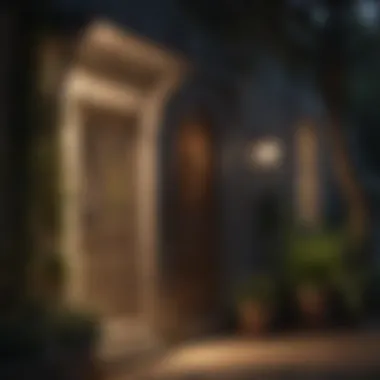
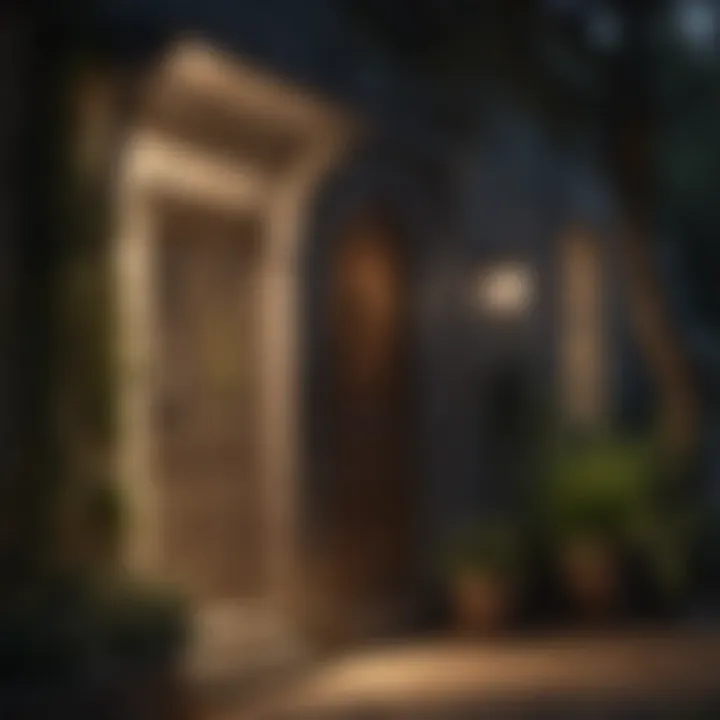
Intro
As the sun sets and the stars begin to twinkle, many homeowners find themselves cranking up the lights at their front doors. It's all about welcoming guests with a warm glow, but there’s a catch—the allure of bright lights can attract unwelcome insect visitors. This article aims to explore effective strategies to discourage insects from congregating around your front door lighting while keeping your entryway inviting and bright. We will delve into various aspects—like choosing the right lighting fixtures, implementing physical barriers, and utilizing natural repellents—to help homeowners create a more enjoyable atmosphere without relying on harsh chemicals or pesticides.
Key Insights and Trends
The importance of outdoor lighting in residential spaces is becoming increasingly recognized. While aesthetically pleasing illumination enhances curb appeal, it's equally crucial to consider ecological factors. This recognition pushes homeowners to strike a balance between style and nature. Let’s dig into some insights worth considering:
Current Trends in Outdoor Lighting
- LED fixtures: These energy-efficient options emit less heat compared to traditional bulbs, making them less appealing to insects.
- Smart lighting: Technology allows for more control over lighting schedules, meaning lights can be timed to minimize insect exposure during peak hours.
- Solar-powered lights: Utilizing solar energy not only cuts down on electricity costs but also minimizes harmful emissions, appealing to environmentally conscious homeowners.
Popular Gardening Techniques of the Season
- Native plants: Incorporating native flora into your garden can create broader ecosystems that naturally deter insects while attracting beneficial pollinators.
- Companion planting: This method pairs plants that repel pests with those that are more susceptible to insect invasions, thus providing a chemical-free safeguard for your front yard.
- Mulching: Organic mulches can help with moisture retention and the health of the soil but can also deter some insect varieties when done correctly.
These trends and techniques reflect a growing awareness among homeowners about the impact of their choices on the environment and their quality of life at home.
Practical Tips and How-To Guides
Now that we’ve set the stage, let’s dive into practical tips to keep those pesky insects at bay while ensuring your front door remains visually inviting.
Step-by-Step Guides for Effective Strategies
- Choosing the Right Lighting:
- Implementing Physical Barriers:
- Natural Repellents:
- Opt for yellow, amber, or sodium vapor lights as they are less attractive to insects compared to traditional white bulbs.
- Install fixtures with louvered designs to direct light downward and reduce visibility for insects.
- Use mesh screens or netting around your entrance to physically keep insects at bay while still allowing airflow.
- Consider installing strategically placed outdoor fans, which can create a gentle breeze that disorients flying insects.
- Essential Oils: Mix a few drops of peppermint or citronella oil with water and spray around the entryway to create a natural deterrent.
- Herbs and Plants: Planting lavender, mint, or basil near your front door can help ward off unwanted visitors, offering fragrance and a pest barrier in one go.
"Integrating these strategies is not just about keeping insects away; it's about enhancing the overall ambiance of your home while showing respect for nature."
- Lighting Maintenance:
- Regularly clean your fixtures to eliminate any residue or dead insects that may attract more pests.
- Change bulbs when necessary, ensuring they are of the appropriate type to minimize attraction.
By following these guidelines, homeowners can enhance their entryways while actively reducing the nuisance caused by unwanted insects, creating a balance of beauty and practicality.
Understanding the Attraction of Front Door Lights
A front door light may seem like just another accessory for the home, but its role extends beyond mere aesthetics. This lighting draws in not just residents and guests, but also insects, making it essential to understand the characteristics that attract various critters. By knowing what draws these insects in, homeowners can better strategize to keep their entrances welcoming and free of flying nuisances.
Biological Reasons for Insect Attraction
Insects are often governed by instinctual behaviors that guide them towards light sources. These light sources emit specific wavelengths, or spectrums, which can attract various types of insects for different reasons.
Light sources and their spectrum
The spectrum of light emitted from different sources can largely influence insect behavior. Insects, particularly moths, are naturally attracted to short-wavelength blue and ultraviolet light. This attraction occurs primarily because these wavelengths mimic sunlight. Evolutionarily, it has been posited that these insects developed their navigation systems based on natural light sources.
However, this characteristic can become a double-edged sword for homeowners. While LED lights, for example, can be energy-efficient and have a longer lifespan, they often emit greater amounts of blue light, increasing the likelihood of insect swarms around front doors. One must tread carefully when choosing the right bulbs—not all light sources are created equal.
Heat emission from bulbs
Aside from light, heat emission plays a pivotal role in attracting insects. Incandescent bulbs, for instance, give off significant heat in addition to light. Insects, being cold-blooded creatures, are naturally drawn to heat sources, as they seek warmth. Therefore, when homeowners opt for these bulbs, they unintentionally create a temperature hotspot that beckons various insects.
Although incandescent bulbs may illuminate entryways beautifully, the heat they emit can draw unwanted guests. This means that choosing the right bulb for one’s front door lighting is about more than just brightness—it’s also about understanding the thermal dynamics at play.
Common Types of Insects Drawn to Lights
Understanding the various insects attracted to front door lighting is equally crucial. Knowledge of the types of insects prevalent in your area helps one anticipate and counteract their appearance.
Moths
Moths are perhaps the most well-known culprits drawn to outdoor lighting. These insects are particularly fascinated by bright lights at night, often swarming around them in large numbers. Their innate behavior to navigate by light makes electric lights irresistible.
While they are generally harmless, the larger concern arises from their tendency to lay eggs near light sources, which could lead to future infestations. Homeowners need to remain vigilant about keeping these lights free from moths to prevent further issues.
Beetles
Another common visitor to front door lighting is beetles. They are typically attracted to lights for a variety of reasons, including foraging for food or seeking out mating partners.
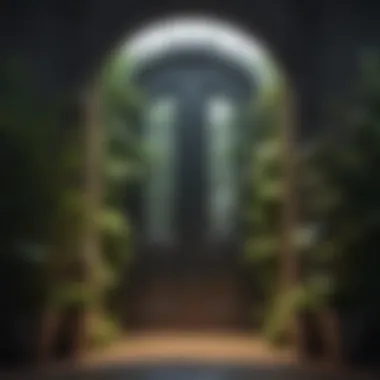

Some beetles, however, can cause real damage to various plants, leaving gardeners especially wary of their presence. Thus, being aware of which kinds of beetles frequent the area can inform lighting strategies that minimize their attraction.
Flying ants
Flying ants add another level of complexity to the issue at hand. Their attraction to light sources is two-fold: they're either scouting for new territories or drawn in by the presence of pheromones emitted by other nearby ants. This makes them more than just a nuisance; they can lead potential residents right to their doorsteps.
Recognizing the specifics of the insects that frequent your front door lighting helps one to develop more effective strategies for deterring them, based on their unique behaviors and attributes.
Understanding why insects are drawn to your lighting is the first step to keeping them away. Choosing the right light sources and making slight adjustments can significantly improve your front door experience.
Choosing the Right Light Fixture
Choosing the right light fixture is an essential step in ensuring that your front door area remains free from the invasion of pesky insects. It goes beyond just aesthetics; the functionality of your lighting plays a critical role in this equation. The type and design of the light you opt for can either attract or repel those uninvited guests. Therefore, understanding various lighting options not only enhances the curb appeal of your home, but it also contributes to a more comfortable environment by minimizing irritation from bugs.
There are a few key elements that you should consider when selecting your light fixtures. These include the type of bulbs, the design of the fixture itself, and how these factors interact with the behavior and biology of the insects you aim to deter. By making informed choices, you can significantly reduce the nuisance created by insects around your entryway.
Types of Bulbs and Their Impact
Incandescent vs. LED
When discussing bulb types, incandescent and LED options are at the forefront. Incandescent bulbs traditionally emit a warm light that many homeowners find inviting. However, this warmth attracts insects, particularly moths and various beetles. The unique feature of incandescent bulbs is their heat emission, which can serve as a beacon for bugs. While they may feel cozy, you're often just rolling out the welcome mat for pests.
On the other hand, LED bulbs are becoming increasingly popular. LED lights tend to emit a cooler light spectrum, which is less attractive to many insects. This not only aids in keeping bugs at bay but also brings about energy savings, a sought-after trait in modern fixtures. The main advantage of LED lights lies in their longevity and lower energy consumption. This makes them a more beneficial choice for the environmentally conscious homeowner.
Color Temperature Effects
The color temperature of your lights is another influencing factor. Lights can range from a warm yellow hue (2700K) to a cooler white (5000K) or even bright blue (6500K). Warmer color temperatures are generally seen as inviting, which is great for ambiance but may draw in insects, particularly during warmer months.
Conversely, cooler temperatures can be a better bet in reducing unwanted visitors. The unique advantage of using cooler color temperatures is their deterrent ability. They appear less enticing to mosquitoes and other flying insects. Opting for bulbs within the cooler spectrum could help shift your front porch from a bug’s paradise to a more insect-less zone.
Shielded Fixtures vs. Open Styles
Why Shielding Matters
Opting for shielded fixtures over open styles is another crucial decision in your quest against insects. Shielded fixtures block light from spilling out into the surrounding area. This characteristic helps in reducing the glowing light that attracts insects, leading them away from your door.
Additionally, shielded features ensure that the light shines downward or illuminates specific areas, decreasing the light's reach into the areas where insects roam. While open fixtures can add charm, they often end up attracting far more critters than they deter. Choosing shielded models is a practical choice for maintaining a bug-free zone.
Design Considerations
Ultimately, when it comes to design considerations, homeowners must balance aesthetics and functionality. Some may lean towards eye-catching designs that stand out, while others prioritize practical use and insect deterrent capabilities. The key here is to merge style with purpose. It's important to note your location; if you're in a region with higher insect populations, a functional approach might save you from a frustrating summer.
Shielding features can be integrated into elegant designs, allowing a homeowner to maintain a beautiful entryway while actively keeping insects at bay. The right fixture lends itself to a well-lit, inviting atmosphere without turning your front door into a landing strip for bugs.
"A well-chosen light can make the difference between a welcoming entrance and a bug buffet."
Utilizing Insect-Repelling Techniques
In the quest to establish a pest-free environment around front door lighting, utilizing insect-repelling techniques is pivotal. These strategies not only maintain the aesthetic appeal of the entrance but also enhance the comfort of the space. By opting for natural or chemical methods to keep insects at bay, homeowners can create a sanctuary from annoying critters without compromising on style or safety. The focus here is on methods that effectively reduce insect attraction, thus offering practical solutions suited for various preferences.
Natural Repellents
Essential oils and their effectiveness
Essential oils have gained popularity as a natural solution for insect repelling. These concentrated plant extracts possess various properties that can deter unwanted insects effectively. For example, oils like peppermint, eucalyptus, and lavender are known for their strong scents, which insects tend to find off-putting. This makes them a popular choice for homeowners looking to minimize chemical exposure while still tackling insects.
One of the unique features of essential oils is their versatility; they can be applied in various ways, such as through diffusers, direct application on surfaces, or mixed in sprays. While they are generally safe for most people when used correctly, their effectiveness can vary based on the species of insect and environmental factors. One advantage to consider is that essential oils do not leave harmful residues, though they do require more frequent application compared to synthetic options.
Homemade sprays
Homemade sprays are another appealing option for deterring insects around front doors. Using common household ingredients like vinegar, water, and specific essential oils, these sprays can be concocted with ease. The key characteristic that makes homemade sprays attractive is their cost-effectiveness; they require minimal investment while providing a non-toxic solution.
One standout feature of these sprays is the ability to customize the formulation based on personal preferences and effectiveness against various insects. While homemade sprays often boast a strong smell, which can be a disadvantage for some, they offer peace of mind for those who might be allergic to stronger chemical repellents. Additionally, the lack of harmful toxins makes such sprays a health-conscious alternative, aligning with a growing preference for eco-friendly solutions.
Chemical Repellents and Their Implications
Types of repellents
Chemical repellents come in various forms, ranging from sprays to granules, and can be very effective against a wide array of insects. One of their main advantages is the potent effectiveness, making them attractive for homeowners seeking swift solutions to insect problems. The key characteristic here is that these repellents usually contain compounds, like DEET or picaridin, which are widely recognized for their potent repelling abilities. They tend to show a rapid reduction in insect presence, allowing for immediate relief.
However, the unique feature of these products is that they often come with warnings regarding safety and environmental impact. Frequent use may require considerations about nearby pets or plants, as some chemicals may not be safe for all residential situations. Therefore, while effective, chemical options should be chosen with care to ensure they don't introduce further harms into the home environment.
Safety considerations
Safety considerations are paramount when using chemical repellents, particularly in homes with children or pets. These products often require careful handling and application to avoid any adverse effects. One compelling feature is the need to always follow the manufacturer’s guidelines to minimize any risk. This is crucial as mishandling can lead to skin irritations or potential poisoning.


Moreover, being aware of potential allergic reactions or sensitivities among family members can further guide the choice of repellent used. Balancing the benefits of immediate pest control with the implications for health and home environment presents a challenge, but it’s one that many homeowners must navigate. The need for continuous assessment of effect and safety underscores the importance of prudent selection when it comes to chemical repellents.
Implementing Physical Barriers
To effectively deter insects from congregating around front door lighting, implementing physical barriers becomes essential. This strategy not only provides a shield against pests but also contributes to a more appealing and functional entryway. By understanding how barriers can work to your advantage, you can minimize the nuisance of insects while still enjoying the warmth of welcoming lights.
Screening Options for Entryways
Door screens
When it comes to door screens, these handy accessories are a practical solution for homeowners looking to strike a balance between keeping insects out and enjoying fresh air. These screens act as a filter, allowing ventilation but obstructing unwelcome guests from entering.
One key characteristic that makes door screens a popular choice is their versatility. Homeowners can find a variety of styles, from magnetic screens that pop open and close with ease to traditional mesh designs that can be fixed in place. This adaptability means homeowners can tailor their choice to suit their specific needs.
What sets door screens apart is their effectiveness in keeping insects at bay while allowing light to filter through. This significantly reduces the chances of insects being drawn to porch lights, offering a win-win for both comfort and light visibility. On the flip side, it's important to note that screens can require regular cleaning, especially in areas prone to debris.
Adjustable features
Adjustable features for door screens elevate functionality by allowing for customization based on the season or specific needs. Homeowners can modify the height and width of these screens to suit their door frame, making it practical for various entryways.
The functionality provided by adjustable features is something that many appreciate. As seasons change, options like retractable screens make it easier to alter air circulation while still keeping bugs out. For instance, a retractable screen can seamlessly tuck away when not in use, maintaining an unobstructed view.
However, one unique aspect of adjustable features is that they can be more expensive compared to fixed options. While the benefits can outweigh the costs in many cases, it's crucial to weigh the budget against the value added by the flexibility these features provide.
Landscaping Choices to Deter Insect Swarms
Plant choices
Selecting the right plants around your front entrance is another effective strategy for creating a repellent zone for insects. Specific plants can naturally deter pests due to their fragrance or chemical makeup. For example, plants such as lavender, rosemary, and marigolds emit aromas that many insects find off-putting.
Key characteristics of beneficial plant choices include not only their ability to repel but also their aesthetic value. Using a combination of visually pleasing and functional plants can enhance the landscaping while providing a barrier against swarms. For those seeking vibrant colors and delightful scents, planting options that deter insects can be a wonderful addition.
Nevertheless, it's vital to consider some plants can attract beneficial insects or pollinators. An imbalance might occur where beneficial insects are lured close, so knowing the specific plants that create this dynamic is essential in preventing unforeseen issues.
Spacing and placement
The spacing and placement of plants play a crucial role in their effectiveness in deterring insects. Properly strategizing how far to place these plants from the front door lighting can maximize their potential. For instance, grouping insect-repelling plants in clusters along pathways or entry points acts as a barrier that discourages pests.
A key characteristic of effective spacing is creating physical distance. Ironically, even a foot or two can make a difference—keeping those plants away from the lighting and directly adjacent surfaces minimizes the chance of attracting unwanted visitors.
However, placing plants too far away might dilute their protective effects. Therefore, it is important to find the sweet spot where plants can be both ornamental and protective, maximizing their role in deterring insects while maintaining an appealing entryway.
"Physical barriers act as the first line of defense. Strategic placements can minimize unwanted access while allowing your home to remain inviting."
Routine Maintenance Strategies
Maintaining front door lighting is not just about aesthetics—it's a crucial factor in keeping those pesky insects at bay. Regular upkeep can make a significant difference in how well your lighting deter unwanted guests. Not only does it prevent the build-up of dead insects and debris, but it also ensures that your fixtures operate at peak efficiency. A little effort goes a long way in creating a comfortable entryway.
Regular Cleaning of Fixtures
Removing dead insects
One specific aspect of removing dead insects revolves around keeping your light fixtures pristine. When insects accumulate around these areas, they can act as a beacon for more bugs, creating a cycle that’s hard to break. The key characteristic of this approach is simplicity; just a quick regular clean-up can drastically reduce attraction. It’s a beneficial practice, primarily for its ability to maintain hygiene and visual appeal.
A unique feature here is the use of a soft brush or cloth to brush away dead insects without damaging the fixture. This method not only clears away the current mess but also helps in inspecting for any potential damage to the fixture caused by prolonged exposure to debris. The main advantage is that you'll extend the lifespan of your lighting, thereby saving money in the long run. On the downside, neglecting this can result in a dingy appearance and may lead to larger pest problems down the line.
Cleaning surfaces
Talking about cleaning surfaces, this involves more than just wiping the bulbs; it means treating the surrounding area too. Dust and grime can create a breeding ground for insects, ultimately attracting more of them. The key trait of this method is thoroughness; the focus is on ensuring that not just the light but also the surfaces surrounding it are kept clean. This is a popular choice for homeowners, as it's an easy step that provides immediate results.
The unique aspect here is that using natural cleaning solutions, like vinegar and water, can further deter insects while ensuring environmental friendliness. This approach has advantages, such as reducing the use of harsh chemicals and maintaining a healthy space for family and pets. However, the disadvantage may come if one doesn’t pay attention to the materials of the surfaces being cleaned, as certain solutions can damage specific finishes.
Seasonal Adjustments for Optimal Performance
Timing changes based on seasons
Timing changes based on seasons plays an essential role in the efficacy of lighting strategies. As seasons shift, so do the behaviors of insects. For instance, during warmer months, the likelihood of insects being drawn to lights increases. The key characteristic of making adjustments according to the season is adaptability; this strategy allows homeowners to be proactive rather than reactive. It’s beneficial as it involves changing the timing of when lights are turned on or off to coincide with insect activity peaks.
A unique feature of this approach is the observation of local weather patterns and their influence on insect populations. This flexibility can make a big difference; for instance, opting for shorter on times during dusk or dawn can significantly reduce the chances of attracting bugs. The downside, however, is that this requires a bit of monitoring and awareness, which some might find cumbersome.
Adapting light intensity
Adapting light intensity is another key aspect that can significantly affect insect attraction. Adjusting how bright your lights are based on the time of year plays a pivotal role in minimizing insect swarms. The essential characteristic of this method is control; it allows homeowners to manage their environment actively. This practice is popular owing to its straightforward application; dimming lights during peak insect seasons can reduce allure effectively.
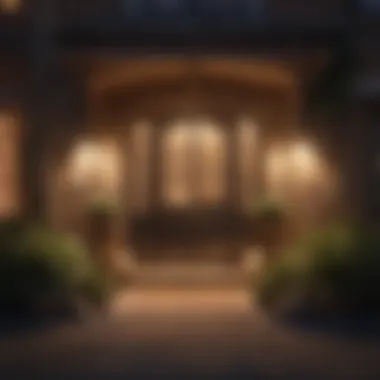
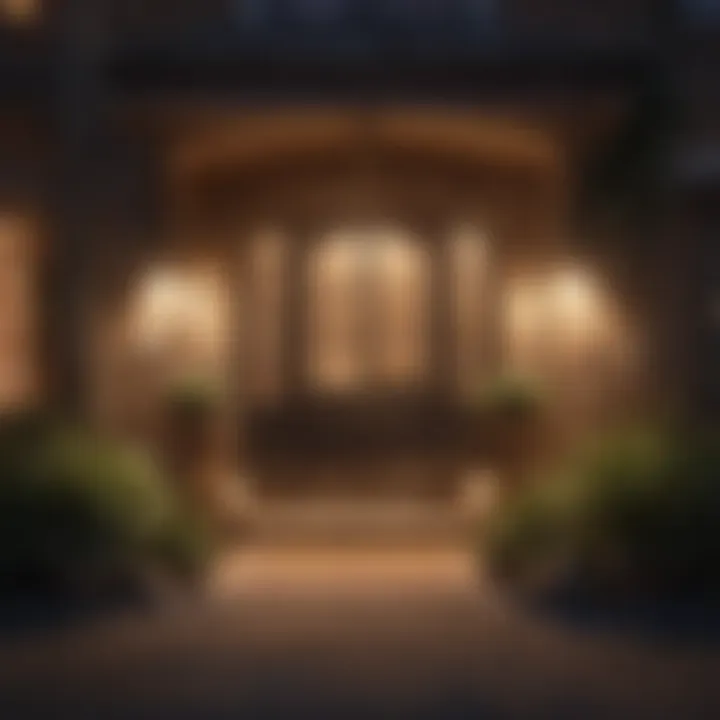
An interesting feature of implementing this idea is the use of smart bulbs that allow for remote control over lumens and brightness. This means you can keep everything in check without being tied down to a switch. The primary advantage here is enhanced flexibility; you can alter settings based on mood or season. Conversely, if one relies solely on traditional bulbs, this may not be as feasible, leading to two challenges: cost-efficiency and convenience.
Regular maintenance of your front door lighting, including cleaning and seasonal adjustments, can dramatically decrease the likelihood of attracting unwanted insects.
Technological Innovations in Insect Control
In an age where technology permeates every aspect of our lives, it comes as no surprise that innovative solutions have emerged to tackle the perennial issue of insects surrounding front door lighting. These advancements offer not just convenience but also efficiency in insect management. By integrating smart technology and advanced designs, homeowners can create an insect-free atmosphere while minimizing their reliance on potentially harmful chemicals. The advent of technology in insect control reflects an ongoing quest to balance comfort with ecological consciousness.
Smart Lighting Solutions
Apps that allow control of lighting
Apps designed to manage lighting systems have transformed the way we handle outdoor illumination. The crux of these applications lies in their ability to give homeowners the power to adjust their lighting with a mere tap on a smartphone. Imagine returning home and, instead of being greeted by swarms of moths and beetles, finding your entrance well-lit and insect-free. These smart apps often allow users to schedule their light's operation, ensuring that lights can be set to turn off during peak insect activity.
Key characteristics of such apps include:
- Remote Accessibility: Controlling lights from anywhere means you can switch them off or on as needed, which discourages insects from gathering during certain times.
- Dimming Options: Gradually adjusting the brightness can help manage insect attraction, as lower light levels can be less inviting.
The unique features of these apps, such as integrating weather updates, allow users to avoid turning on lights during damp, humid nights when insects are particularly active. Nevertheless, one must weigh the cost of such technology against its benefits. While they enhance convenience, potential connectivity issues might disrupt their functionality.
Automated systems
Automated systems elevate the convenience of managing front door lighting and insect control to new heights. These setups typically involve sensors that can automatically detect ambient light levels, adjusting themselves accordingly. For instance, as dusk falls, the lights could turn on just enough to illuminate pathways without being too bright.
The advantages of these systems stem from their hands-free operation, ensuring your lighting works without constant input from you. Homeowners appreciate this easy setup, especially during gatherings when manual operation is less feasible.
However, the integration of smart sensors also requires an initial investment, which can range based on the technology’s complexity. The primary advantage is the automation: for example, if a motion is detected near the door, lights can flare up momentarily but dim again once the area is cleared, curbing excessive insect attraction.
Insect Traps and Deterrents
Incorporating traps into your insect control strategy can make a significant difference. These devices not only capture nuisance insects but also deter them from returning in the future. With technology, these traps are no longer simple sticky devices; they have evolved into sophisticated instruments employing various principles to fend off unwanted bugs.
UV light traps
UV light traps harness the natural attraction insects have to light, utilizing this to capture them effectively. These systems set against your door will emit UV rays that draw insects in, where they are then trapped. The highlight of these traps is their reliance on a natural instinct, which makes them particularly effective for various insects, including moths, flies, and beetles.
This approach is beneficial as it negates the need for harmful insecticides. Unique features of modern UV traps include:
- Low Power Consumption: Many of them are energy-efficient, using minimal electricity.
- Easy Maintenance: Advanced models often come with user-friendly designs, allowing simple cleaning or bulb replacements.
However, it's essential to remember that these traps might attract insects that are not a nuisance, leading to an influx of other bug types. But on the whole, they provide a cleaner, eco-friendly solution.
Smart sensors
Smart sensors integrate seamlessly with modern lighting solutions, creating an intelligent network capable of detecting not just presence but also the types of insects nearby. Their capability to identify atmospheric conditions makes them increasingly valuable in insect control.
These sensors operate on the principle of gathering data, which can be analyzed to determine optimal conditions for light operation and to assess insect activity patterns around your front door.
The benefits include:
- Alerts: Many systems can send notifications to your mobile device when insect activity is detected, allowing timely intervention.
- Adaptive Technology: Over time, they can learn and adjust the lighting based on patterns, avoiding times when insects are most active.
Yet, similar to other tech solutions, the initial cost and system complexity could deter some homeowners. Plus, dependence on technology raises concerns about data privacy and reliability.
Evaluating the Effectiveness of Strategies
In the quest to keep pesky insects at bay around your front door lighting, it’s essential to step back and assess how well your tactics are working. Evaluating effectiveness is not just a matter of trial and error; it involves understanding which strategies truly make a difference. Homeowners need to comprehend the interplay between their chosen methods and the actual impact those methods have. A well-evaluated strategy can save time, money, and effort, ultimately leading to a more pleasant outdoor experience.
Metrics for Measuring Success
Observation techniques
Observation techniques refer to the systematic process of watching insect behavior around your front door lights. One critical part of this is to take careful note of when and where insects seem to congregate. This method isn’t merely about counting the bugs; it’s about understanding patterns over time. For instance, some might notice that moths prefer certain types of bulbs or that swarming happens more with particular seasonal shifts.
A key characteristic of observation is that it allows for organic data collection without invasive measures. This approach is often favored by homeowners because it doesn’t require purchasing additional tools or products. The unique aspect of observation techniques is their adaptability—one can keep refining their observations as the seasons change. However, the disadvantage might be that this method can be time-consuming, requiring consistent attention and patience.
Record-keeping
Keeping detailed records of your findings surrounding insect activity can enhance your understanding of how effective your strategies are. Record-keeping often involves jotting down dates, types of insects observed, and the conditions present during their visits. This habit can illuminate trends, allowing homeowners to pinpoint what works and what doesn’t. One noteworthy trait of keeping records is its cumulative benefit; over time, you accumulate a wealth of knowledge that can aid in developing targeted strategies. It becomes especially beneficial when trying different combinations of light fixtures and repellents. However, some might find this task burdensome, especially those who prefer a more hands-off approach to home maintenance. Ultimately, a dedicated record can arm you with the necessary insights to create a sanctuary free from unwanted guests.
Adapting Strategies Based on Results
Adapting strategies based on observed results is crucial for ongoing effectiveness. As seasons and environments shift, so too do the behaviors of local insect populations. Homeowners must remain flexible—what worked last summer might not hold true this fall.
Adjusting based on seasonal patterns
When it comes to adjusting according to seasonal patterns, it’s all about timing. Some insects, like certain moths, are more active during specific climatic conditions. They may be drawn to light sources more vigorously on humid, warm nights than during cooler spells. Acknowledging this characteristic allows you to preemptively alter your lighting setup or insect deterrents before a major influx occurs. This adaptability could mean switching to a less inviting color spectrum of light or turning off fixtures altogether during peak hours. The strategy becomes particularly beneficial as it involves proactive rather than reactive measures. However, the potential downside is that it requires continuous monitoring and possibly additional planning in the lead-up to seasonal changes.
Tweaking lighting setups
Tweaking lighting setups involves making adjustments to the type, placement, and timing of your lights in relation to the insect activity observed. This might include altering the height of fixtures, using different wattages, or even experimenting with motion sensors that only activate lighting when needed. The beauty of this strategy lies in its potential for tailored solutions that fit any home’s aesthetic or functional needs. A unique feature of this approach is that it grants homeowners the freedom to mix and match various solutions until the perfect environment is created. The drawback here may be the initial investment in different types of fixtures or bulbs and possibly the upkeep involved in maintaining a consistent tweaking practice. But ultimately, a few earned adjustments can lead to substantial reductions in unwelcome insect presence around your entryway.
“The key to a comfortable outdoor space lies not just in choosing a direction, but in being willing to adjust course whenever necessary.”



